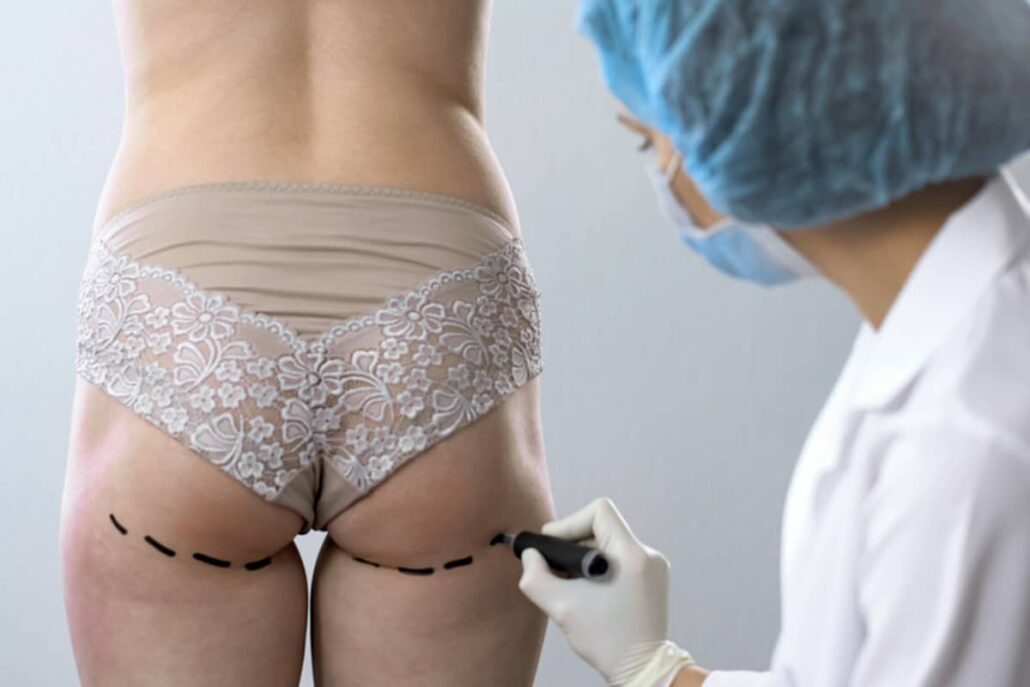
Brazilian Butt Lift (BBL) surgery, a popular cosmetic procedure, involves liposuction and fat transfer to achieve rounder and more youthful buttocks.
This procedure differs from traditional lift procedures, such as facelifts or breast lifts, as it adds volume and improves the shape of the buttocks but doesn’t directly address sagging or excess skin.
The demand for BBL is on the rise and is considered safer than other surgeries, like silicone implants. However, you should be aware of any potential BBL risks or complications so you can make the best decision.
What to Expect from BBL Surgery
- BBL surgery involves liposuction and fat transfer to enhance the shape of the buttocks.
- Potential risks during surgery include infection, bleeding, and complications related to anesthesia.
- Post-operative risks such as fluid accumulation, fat embolism, and scarring require careful monitoring.
- Choosing a board-certified surgeon is crucial to minimize risks and achieve optimal results.
- Following post-surgery recovery guidelines and lifestyle changes can ensure a smooth healing process and better outcomes.
Understanding the BBL Risks
Understanding the possible risks and complications of BBL is important for anyone thinking about this cosmetic procedure. These risks can happen during and after the surgery, and they can vary in severity.
Potential Complications During Surgery
Infection and Bleeding Risks
There is a chance of infection if bacteria get into the body during the procedure or afterward. Another possible issue is hematoma, where blood collects under the skin due to leakage, which can happen if blood vessels are damaged during the procedure. This buildup of blood may also result from clotting disorders or blood pressure problems.
Risks of anesthesia
Surgeons use general anesthesia during plastic surgery to ensure that patients are unconscious and incapable of feeling pain. Adverse reactions to anesthesia may be a potential risk, and these risks usually start after BBL surgery. The risks can range from mild nausea and vomiting to severe, life-threatening conditions like respiratory distress or allergic reactions.
Damage to Surrounding Tissues
There is a possibility of unintentional harm to the tissues around the treatment site during surgery. This may cause extended swelling, discomfort, and a longer recovery time. In certain instances, it could also result in nerve damage or injury to the gluteal muscles.


SPECIALIST CARE YOU CAN TRUST
Dr. Salloum is supported by a brilliant team of caring staff members.
You can trust the entire staff to help make your visit as comfortable and safe as possible!
Post-operative Risks and Complications
Seroma Formation and Fluid Accumulation
Seroma is a condition characterized by the accumulation of serous fluid in a pocket under the skin. This might occur weeks after surgery and can cause discomfort, requiring additional procedures to drain the excess fluid. To minimize the risk of seroma formation, patients are advised to wear compression garments as prescribed by their experienced surgeon. It is important to avoid strenuous activities that may disrupt the healing process.
Fat Embolism and Its Potential Dangers
Another serious post-operative risk is fat embolism, which occurs when fat enters the bloodstream and potentially blocks blood vessels, leading to severe complications like heart attack or stroke. This risk underscores the importance of choosing a qualified plastic surgeon who uses safe and approved fat grafting techniques to minimize the chance of potential complications.
Scarring and Skin Irregularities
While scarring is a normal part of healing, some patients may experience noticeable or unsightly scars. Uneven skin results, such as lumpiness or contour irregularities, can occur if the transferred fat cells do not survive or distribute evenly. Following post-operative instructions and maintaining a healthy lifestyle can help minimize these risks.
Persistence of Asymmetry or Dissatisfaction with Results
You might not be satisfied with the outcome despite the surgeon’s best efforts. This could mean that the buttocks are not symmetrical, or the results of the butt lift dissatisfies you. In such cases, additional procedures are required. To reduce this risk, it’s always a good idea to communicate clearly with the surgeon about aesthetic goals before the procedure and to have realistic expectations.
Importance of Choosing a Qualified Surgeon
The Brazilian Butt Lift (BBL) surgery is a complex cosmetic surgery procedure that demands a high level of expertise, precision, and a deep understanding of the body’s contour and individual body type. This procedure is not just about enhancing the buttock size but also about achieving a harmonious body transformation.
A board-certified plastic surgeon can significantly minimize potential complications such as infection after surgery, blood clot formation, nerve damage, and fat necrosis. It can also ensure optimal aesthetic outcomes, maintaining the balance between patient safety and desired results.

It’s advisable to research the surgeon’s credentials thoroughly. Look for a reputable surgeon who has a proven track record, ask to see before and after photos of previous patients, and seek recommendations and reviews.
Preparing for BBL Surgery
Preparing for BBL surgery with a skilled plastic surgeon is crucial to reduce complications and achieve the best outcomes. It’s advisable to steer clear of cheap plastic surgery options or cosmetic surgery tourism spots. Opt for a board-certified surgeon in a licensed surgical facility instead.
A consultation is the first step before surgery, where the surgeon will assess your health, body type, and excess body fat, discussing the risk of complications like infection, blood clot formation, nerve damage, and fat necrosis. If you have blood clotting disorders or blood pressure issues, discuss these, as they can impact the surgery and recovery.
Pre-surgery instructions may include quitting smoking 2-4 weeks before surgery. Avoid blood thinners and excessive alcohol, as these can interfere with your blood flow and the recovery process. It can also increase the risk of bleeding and cause hematoma.
Post-Surgery Care and BBL Recovery
Recovery after BBL surgery is important for achieving aesthetic goals. Following your surgeon’s recovery guidelines helps reduce complications and promotes healing. Wearing compression garments can minimize swelling and help maintain the shape of the buttocks. It also prevents seroma. Taking prescribed medications is essential for managing pain and preventing infection that may happen during or after the procedure.
It’s recommended to seek immediate medical attention if you experience excessive pain, continued swelling or redness, or any signs of infection such as fever, chills, or pus from the incision sites.
Recommended Lifestyle Changes and Precautions During the Recovery Period
Depending on your job, you may be able to return to work between 10 and 14 days after the BBL procedure. However, suppose your job involves sitting for long periods of time. It may be advisable to use a standing desk or a special cushion that avoids pressure on the buttocks until you have completely healed.
Avoiding strenuous activities until you’re cleared by your surgeon is also required. This is done to prevent unintentional damage to the tissues around the treatment area, which could lead to persistent pain and excessive swelling as well as a longer recovery time. Taking precautions during your recovery period and quickly reporting any unusual symptoms to your surgeon is recommended.
Choosing a BBL Surgery
When considering a Brazilian Butt Lift (BBL) surgery, thorough research and clear communication with the cosmetic surgeon are essential for understanding the procedure, potential risks, and expected outcomes. This ensures a safer experience and a higher likelihood of achieving desired results while prioritizing safety.
At the Miami Center for Plastic Surgery, double board-certified surgeon Dr. Gabriel Salloum and his team are committed to providing the highest level of care and expertise in BBL surgery. If you’re considering a BBL, we invite you to schedule a consultation by filling out a contact form or calling 305-405-6910. We look forward to discussing your aesthetic goals and sharing more information about the procedure with you.